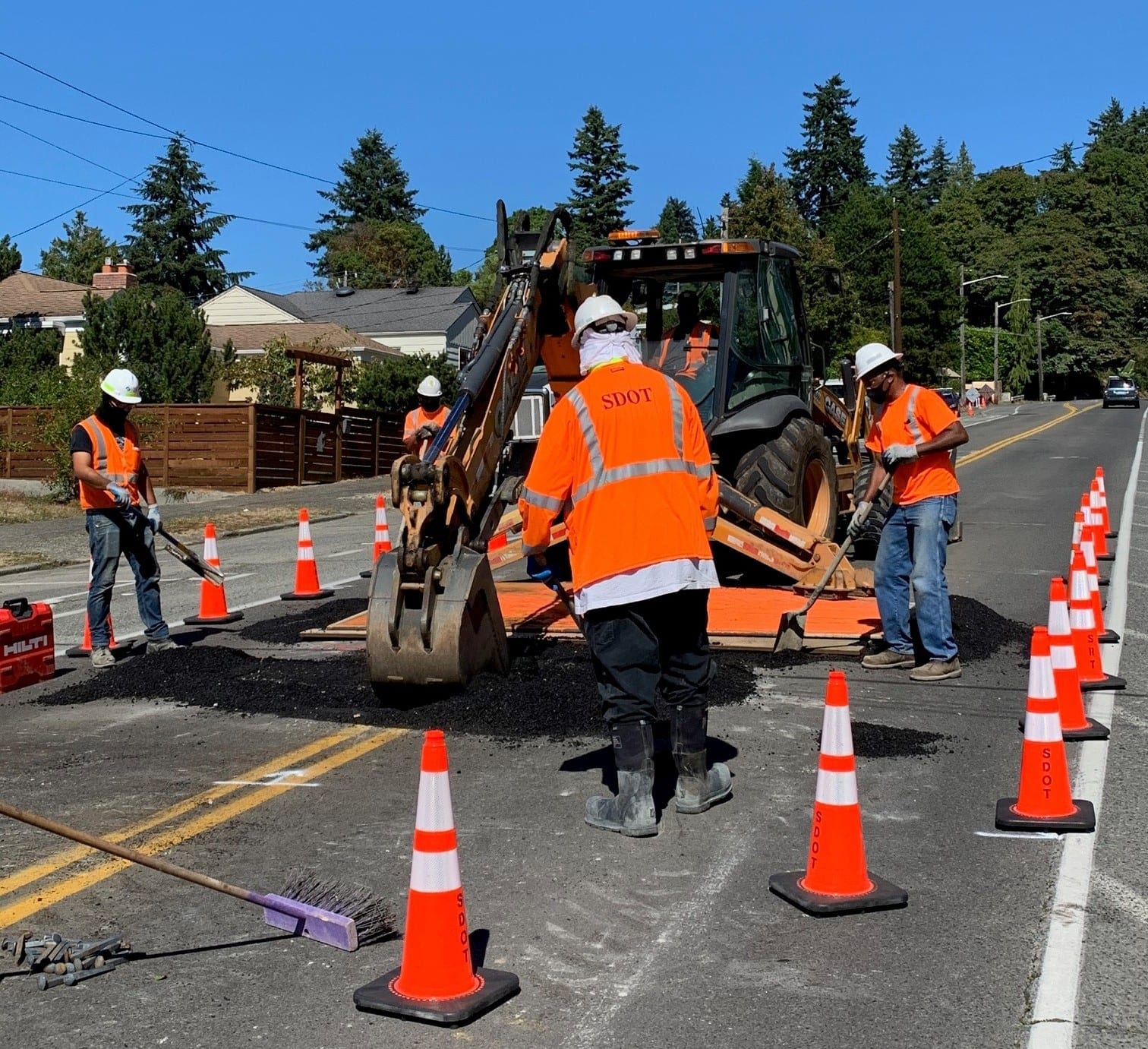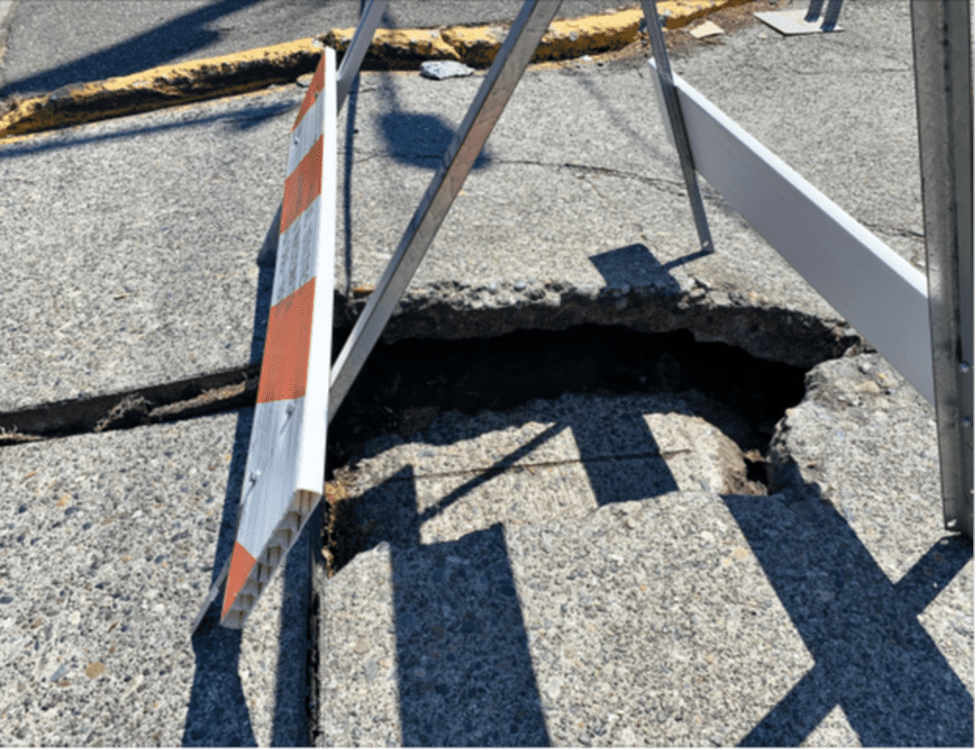 Crews fill a sinkhole on Admiral Way SW last year. Photo: SDOT
Crews fill a sinkhole on Admiral Way SW last year. Photo: SDOT Update [August 10, 2021]: Visit this blog post for an update on the repairs that we made following June’s extreme heat. All of the locations listed in this blog have been reopened.
After a week of historic high temperatures reaching 108 degrees on Monday, June 28, the extreme heat has caused severe damage to roads around Seattle. Over the past week, our engineers have evaluated reported road damage around the city and identified six locations requiring street closures and major repairs. We are prioritizing repairs based on public safety and impact to the traveling public, and have already completed repairs to damage on West Marginal Way, begun repairs on 36th Ave SW, and are working to schedule repairs in four other locations.
We want to take a moment to say thank you to our workers who are braving the heat to support our transportation infrastructure and help keep people moving safely around the city in challenging working conditions.
“With all the negativity in the world along with the list of complaints I’m sure you hear about, I wanted to take a moment and send a genuine THANK YOU to SDOT for jumping into action on the road closure due to the heat. At the end of the day, your team has knocked this one out of the park and as someone running a business I can’t explain how much it means to us to have the response that SDOT provided.”
Kory Love, General Manager of Alki Lumber
Our crews were ready to respond to extreme heat damage.
Extreme heat or cold can both damage our roads and bridges. While concrete is designed to expand in hot temperatures and contract in the cold, exceptionally hot weather can sometimes heat the road so much that the expanding pavement has nowhere else to go but up, creating “buckles” in the road.
When road damage is reported to us, our engineers act quickly to evaluate the extent of the damage and create a repair plan. Concrete repairs are challenging and complicated work which can sometimes take several days or weeks to complete. Because our crews cannot be everywhere at once, we have to prioritize the work based on factors like public safety and how important the route is to the travelling public.

We have currently identified at least six high-priority locations based on the severity of the pavement damage:
- West Marginal Way (north of Highland Park Way SW)
Status: Immediate repairs have been completed and road currently open. - 36th Ave SW (Between SW Avalon Way & SW Oregon St)
Status: Repairs are completed and the road was reopened at 7:30 am on July 9. - S Angeline St & 38th Ave S Intersection
Status: Eastbound lane S Angeline St is closed. Working to schedule repairs. - NE 68th St (between 51st Ave NE & 52nd Ave N)
Status: Road closed (residents may access their driveways with local access only from 52nd Ave NE). Working to schedule repairs. - SW Holly St (between 40th Ave SW & 41st Ave SW)
Status: Road closed (residents have access to their driveways, local access only). Working to schedule repairs. - 4th Ave S (between S Spokane St & S Industrial Way)
Status: All lanes are open with speed reductions crossing a raised utility trench. Motorcycles should use extreme caution and watch out for “bump” warning signs. Working to schedule to repairs.
Update [August 10, 2021]: Visit this blog post for an update on the repairs listed above. All of the locations have been reopened.
Crews worked through the night to make urgent repairs to West Marginal Way
One of our highest priorities this week was repairing severe pavement damage on West Marginal Way north of Highland Park Way SW where concrete buckled in the heat. Due to the West Seattle High-Rise Bridge closure, this street has become a critical route in and out of West Seattle and so crews rushed to get the repairs done as quickly as possible.
Workers first installed a temporary asphalt patch on the damaged pavement on Sunday night. However, Monday’s record-breaking heat and heavy traffic caused this immediate fix to deteriorate quickly, and we could not count on it to hold up through the Fourth of July weekend traffic.
To create a longer-term solution, crews worked through the night starting at 2 a.m. on Wednesday, June 30 to remove the concrete panel entirely and create a deeper asphalt patch. This was originally expected to take up to 10 hours, but crews were able to get it done sooner and reopened the road at about 8 a.m.
This area will eventually need to be completely repaved with concrete, but we are hopeful that this solution will last for at least a year so that the more lengthy closures can occur after the West Seattle Bridge reopens.
Long lasting, high-quality repairs take time but are well worth it.

This morning, we began work on a lengthy repair to damaged concrete on 36th Ave SW between SW Avalon Way & SW Oregon St.
This project work is a good example of how challenging and complicated these pavement repairs can get.
The heat caused pavement to rise up around a Seattle Public Utilities maintenance hole, and so our crews need to work around utility inspections and active utility infrastructure. Unlike work that was planned months in advance, crews also need to be adaptable and nimble to adjust to the exact conditions in the field. For example, this location is at the apex of a small hill which will require carefully fitting the concrete to match the exact street elevations.
To create a long-term term fix, crews will need to completely demolish, remove, and replace eight massive concrete panels. This solution will last much longer than temporary asphalt patchwork, but it also takes longer to complete and work may last as long as July 16.
[UPDATE: This work was completed a week ahead of schedule, and the street reopened at 7:30 a.m. on July 9]
We’re proud of our work, and committed to devote the time necessary to build long-lasting repairs. So repairing all the recent damage will likely take several weeks and we also expect to continue seeing more pavement damage throughout the summer, meaning that our crews will continue to be hard at work over the next several months.

Remember, we can only fix a problem that we know about. If you see road damage, please call 206-684-ROAD, email 684-ROAD@seattle.gov or use the Find It, Fix It app to report the issue.
Every season brings different kinds of challenges to respond to, and SDOT crews work year-round to maintain to our roads, sidewalks, and curb ramps, too!
Working year-round in rain, sleet, snow, and now record-setting heat conditions, their dedication and resilience is a major reason our transportation system continues to work for the traveling public. These workers inspect bridges, maintain traffic signals, fill potholes, install safer walkways and bike lanes, post detour signs, flag traffic, clean up roadway debris, remove graffiti, and so much more.
Road repairs are a never ending job. In 2020, our crews filled 15,000 potholes. High temperatures can often cause previously repaired potholes to form again so our crews will be ready to respond and repair them again.
Members of our crews continue to meet the demands of operating and maintaining of a robust network of streets, sidewalks, bridges and other public infrastructure across the entire city.
So please take a moment to say “thank you” to these workers and recognize their contributions to Seattle and its residents. Our workers are community members themselves, and public servants working to improve the city they care deeply about.
Most importantly, when you see workers in the street while you are driving in your neighborhood, please “Give ‘Em a Brake” and slow down to help ensure their safety so they can go home safe to their families every night.


